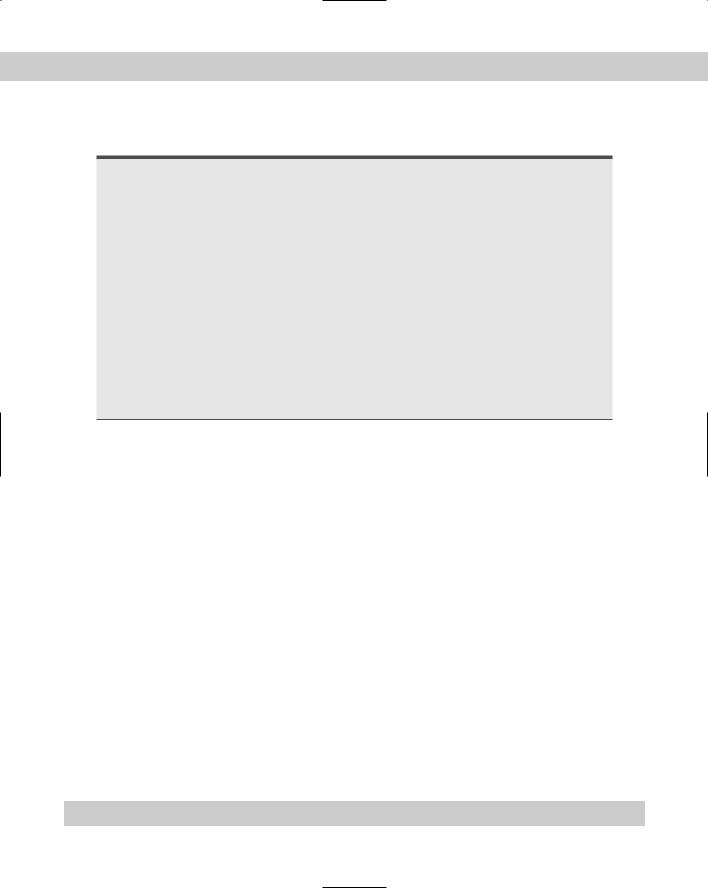
- •About the Author
- •Credits
- •How This Book Is Organized
- •Part I: Linux Basics
- •Part II: Installation
- •Part III: Configuration
- •Part IV: Administration
- •Part V: Maintaining the Linux System
- •How Each Chapter Is Structured
- •How to Use This Book
- •Conventions Used in This Book
- •What is Linux?
- •The origin of UNIX
- •Who started Linux?
- •Understanding Open Source
- •Understanding Closed Source
- •Understanding Artistic License
- •Is Freeware really free?
- •Is Shareware never free?
- •A comparison and contrast of licensing methods
- •The Growth of Linux
- •Linux on a Personal Computer
- •Graphical installation
- •Hardware detection
- •Graphical user interface
- •Linux limitations on the PC
- •Linux succeeds on the PC
- •Linux on workstations
- •Linux on servers
- •Summary
- •Assessment Questions
- •Scenarios
- •Answers to Chapter Questions
- •Assessment Questions
- •Scenarios
- •Linux Kernel
- •Kernel versions
- •Kernel availability
- •Linux Distributions
- •Beehive
- •BlueCat
- •Caldera OpenLinux
- •Debian
- •Corel
- •DragonLinux
- •Elfstone
- •Gentoo
- •Hard Hat Linux
- •KRUD
- •LinuxPPC
- •Mandrake
- •Phat Linux
- •Slackware
- •StormLinux
- •SuSE
- •TurboLinux
- •Yellow Dog Linux
- •Mini and Specialty Distributions
- •Astaro
- •KYZO
- •FlightLinux
- •NetMAX
- •Packages and Packaging Solutions
- •Red Hat Package Manager
- •Debian Package Management System
- •Tarball
- •Linux Resources
- •Summary
- •Assessment Questions
- •Scenarios
- •Lab Exercises
- •Answers to Chapter Questions
- •Assessment Questions
- •Scenarios
- •Linux In the Real World
- •Word Processing
- •Spreadsheets and databases
- •Web browsing
- •File transfer
- •More, more, and more applications
- •The Server and DNS
- •A Linux Web server
- •Linux e-mail server
- •File servers
- •Proxy, news, and search servers
- •FTP servers
- •Firewalls
- •Determining Linux Roles and Services
- •Comparing Linux with other operating systems
- •Hardware compatibility
- •Summary
- •Assessment Questions
- •Scenarios
- •Answers to Chapter Questions
- •Assessment Questions
- •Scenarios
- •Installing Linux
- •Final Preparations for Installation
- •Verification
- •Package selection
- •Final hardware verification
- •Pre-installation partitioning planning
- •Installing Linux
- •Text or GUI installation
- •Basic setup of Linux
- •Selecting the machine type
- •Partitioning the hard disk drive
- •Installing a boot manager
- •Creating the Boot Diskette
- •Networking
- •Additional installation information
- •Accounts and passwords
- •Additional packages to install
- •GUI installation
- •Obtaining video card information
- •Configuring the X windows system
- •Selecting the windows manager or desktop environment
- •Summary
- •Assessment Questions
- •Scenarios
- •Lab Exercises
- •Answers to Chapter Questions
- •Chapter Pre-test
- •Answers to Assessment Questions
- •Scenarios
- •Alternative to the GUI Installation
- •Command Line installation
- •Install the Linux system
- •Network installations of Linux
- •Review of a Linux Installation
- •Installation media
- •Initial selections
- •Installation type or class
- •Disk partitioning and formatting
- •Installing LILO
- •Network configuration
- •User accounts
- •Authentication methods
- •Package selection and installation
- •A Dual-Boot Installation of Linux
- •Linux with Microsoft Windows
- •Linux with Microsoft Windows NT and 2000
- •Linux and Solaris
- •Linux and other operating systems
- •Installing Additional Software with gzip and tar
- •Installing Additional Software with RPM
- •Removing software with RPM
- •Upgrading software with RPM
- •Query the RPM software
- •Verify the RPM software
- •Verify the package files
- •Upgrading the Kernel
- •Upgrading a Linux Kernel
- •System Log Files
- •The Final Test of the Installation
- •Summary
- •Assessment Questions
- •Scenarios
- •Lab Exercises
- •Answers to Chapter Questions
- •Chapter Pre-test
- •Assessment Questions
- •Scenarios
- •What is the X Window System?
- •The X Window System
- •X Client and Server communications
- •X Window Manager
- •Configuring X Window Systems
- •Custom X Window System Programs
- •Manual Configuration of the X Window System
- •Documentation
- •Summary
- •Assessment Questions
- •Scenarios
- •Lab Exercises
- •Answers to Chapter Questions
- •Chapter Pre-test
- •Assessment Questions
- •Scenarios
- •Basic Network Services
- •TCP/IP Protocol Suite
- •Connection protocols needed
- •Other network protocols
- •Configuring Basic Network Services
- •Host name
- •IP addressing
- •DHCP
- •Netmask
- •Hardware resources
- •Routing and gateways
- •PPP, SLIP and PLIP connections
- •Server Tasks with
- •IP aliases for virtual hosts
- •Apache Web Server
- •Samba File Server
- •Home directories
- •Disk shares
- •Configuring Client Services
- •SMB/CIFS
- •NIS client configuration
- •NFS client configuration
- •Configuring Internet Services
- •Web browser
- •POP and SMTP
- •TFTP
- •SNMP
- •Remote Access
- •Rlogin
- •Telnet
- •OpenSSH
- •Documentation
- •Summary
- •Assessment Questions
- •Scenarios
- •Lab Exercises
- •Answers to Chapter Questions
- •Chapter Pre-test
- •Assessment Questions
- •Scenarios
- •Adding Hardware
- •Memory
- •Swap
- •Adding a hard drive
- •Video and monitor
- •Printers
- •Configuration files
- •Setting environment variables
- •BASH
- •Documentation
- •Summary
- •Assessment Questions
- •Scenarios
- •Lab Exercises
- •Answers to Chapter Questions
- •Chapter Pre-test
- •Assessment Questions
- •Scenarios
- •Basic User and Group Administration
- •What are users and groups?
- •Creating users
- •Change user information
- •Deleting users
- •Creating groups
- •Getting Around Linux
- •Navigating Linux
- •Common file and directory commands
- •Setting File and Directory Permissions
- •Mounting and Managing File Systems
- •Mount
- •Umount
- •Mounted file systems
- •Summary
- •Assessment Questions
- •Scenarios
- •Lab Exercises
- •Answers to Chapter Questions
- •Chapter Pre-test
- •Assessment Questions
- •Scenarios
- •Multi-User Environment
- •The creation of Virtual Consoles
- •The Linux Terminal Server Project
- •Configurations for remote systems
- •Monitoring remote connections
- •Common Shell Commands
- •Basic shell scripts
- •Caution using root access
- •Navigating the GUI interface
- •Summary
- •Assessment Questions
- •Scenarios
- •Lab Exercises
- •Answers to Chapter Questions
- •Chapter Pre-test
- •Assessment Questions
- •Scenarios
- •Linux Runlevels
- •init
- •Shutting down Linux
- •Managing Linux Services
- •Configuring Linux Printing
- •lpd daemon
- •/etc/printcap
- •Printing management
- •Using the vi Editor
- •vi operation modes
- •Editing text files
- •Using the
- •Summary
- •Assessment Questions
- •Scenarios
- •Lab Exercises
- •Answers to Chapter Questions
- •Chapter Pre-test
- •Assessment Questions
- •Scenarios
- •Disk and File System Management
- •Repairing Partitions
- •System Automation and Scheduling
- •cron
- •Core Dumps
- •Analyzing core dumps
- •GNU Debugger
- •Managing Networking Interfaces
- •Installing System Packages and Patches
- •Compressed archive
- •Debian Package Installer
- •Slackware Package Installation
- •Summary
- •Assessment Questions
- •Scenarios
- •Lab Exercises
- •Answers to Chapter Questions
- •Chapter Pre-test
- •Assessment Questions
- •Scenarios
- •Linux Processes
- •Core services versus non-critical services
- •Process administration
- •Process control
- •Monitoring Log Files
- •Maintaining Documentation
- •Summary
- •Assessment Questions
- •Scenarios
- •Lab Exercises
- •Answers to Chapter Questions
- •Chapter Pre-test
- •Assessment Questions
- •Scenarios
- •Linux Security
- •Securing the Environment
- •Location
- •Environment
- •System Security
- •System/user files
- •Permissions
- •Log auditing
- •Backups
- •Linux Security Best Practices
- •Network security
- •Firewall
- •System security
- •Securing a Web server
- •Securing an FTP server
- •FTP program version
- •FTP configuration files
- •Process security
- •Summary
- •Assessment Questions
- •Scenarios
- •Lab Exercises
- •Answers to Chapter Questions
- •Chapter Pre-test
- •Assessment Questions
- •Scenarios
- •Disaster Recovery Planning
- •Types of data
- •Frequency and Scheduling
- •Storage and media types
- •Recovering data
- •Offsite storage
- •Linux Backup Tools and Commands
- •Third party tools
- •Tape devices
- •Summary
- •Assessment Questions
- •Scenarios
- •Lab Exercises
- •Answers to Chapter Questions
- •Chapter Pre-test
- •Assessment Questions
- •Scenarios
- •Identifying the Problem
- •Methodology and Best Practices
- •Troubleshooting Resources
- •Documentation resources
- •Internet resources
- •System Log Files
- •Tools for Log Files
- •Output to another file
- •Locating files
- •Process Configuration and Management
- •Stopping, Starting, and Restarting Processes
- •Configuration Files
- •Summary
- •Assessment Questions
- •Scenarios
- •Lab Exercises
- •Answers to Chapter Questions
- •Chapter Pre-test
- •Assessment Questions
- •Scenarios
- •Examining the Startup Process
- •Boot process steps
- •Analyzing Boot Process Errors
- •Common Boot Problems
- •Using System Status Tools
- •File System Check
- •System Resource Commands
- •Using the System Boot Disk
- •Types of boot disks
- •Creating a boot disk
- •Creating a rescue/utility disk
- •Summary
- •Assessment Questions
- •Scenarios
- •Lab Exercises
- •Answers to Chapter Questions
- •Chapter Pre-test
- •Assessment Questions
- •Scenarios
- •Common User Problems
- •Login problems
- •File and directory permissions
- •Printing problems
- •Mail problems
- •Software Package Problems
- •Package dependencies
- •Software and version conflicts
- •Backup and Restore Errors
- •Backup hardware
- •Backup software
- •File restore errors
- •Application Failures
- •Log files
- •Process and daemon errors
- •Web server errors
- •Telnet
- •Mail services
- •Basic Networking Troubleshooting
- •Networking connectivity
- •Network hardware problems
- •Summary
- •Assessment Questions
- •Scenarios
- •Lab Exercises
- •Answers to Chapter Questions
- •Chapter Pre-test
- •Assessment Questions
- •Scenarios
- •Mainboard Components
- •BIOS
- •System memory
- •System Resources
- •I/O addresses
- •Direct memory access
- •Laptop Considerations
- •PCMCIA
- •Linux Peripheral Configuration
- •Installing and Configuring SCSI Devices
- •SCSI definitions
- •SCSI technologies
- •SCSI cabling and termination
- •SCSI device configuration
- •Linux SCSI devices
- •ATA/IDE Devices
- •IDE drive configuration
- •Linux ATA/IDE Drive configuration
- •Linux Support for Other Devices
- •IEEE 1394 (Firewire)
- •Summary
- •Assessment Questions
- •Scenarios
- •Answers to Chapter Questions
- •Chapter Pre-test
- •Assessment Questions
- •Scenarios
- •What’s on the CD-ROM
- •System Requirements
- •Using the CD with Microsoft Windows
- •Using the CD with Linux
- •Microsoft Windows applications
- •Linux applications
- •Troubleshooting
- •Sample Exam
- •Exam Questions
- •Exam Answers
- •Taking a CompTIA Exam
- •How to register for an exam
- •What to expect at the testing center
- •Your exam results
- •If you don’t receive a passing score
- •About the Linux + Exam
- •Preparing for the Linux+ Exam
- •For More Information
- •Preamble
- •No Warranty
- •Glossary
- •Index

324 Chapter 9 Study Guide
4.Return to the login directory and verify the directory.
5.Create a file in the home directory without opening an editor.
6.Copy that file to another directory on the system, try several and notice any that disallow access.
7.Create another file then move that file from directory to directory.
8.Remove all files that were created by navigating to the directory they are located in and listing them before removal.
Lab 9-2 Mounting and un-mounting drives
The objective for this hands-on lab is to gain experience in mounting and unmounting. You should be able to use any distribution of Linux for this installation exercise.
1.Log in to the Linux system.
2.Use the proper commands to view the current mounted directories and devices.
3.Mount a diskette using a method that verifies that the mount was successful.
4.Un-mount the diskette.
5.Attempt to un-mount a system directory; take note of what can and can’t be dismounted.
6.Repeat as often as possible trying several of the options available.
Answers to Chapter Questions
Chapter Pre-test
1.The creation of a user normally requires a user name, password, group assignment, user rights, and real world information, such as name, location, and contact numbers.
2.You need to know who is to be assigned to the group, what files and directories the group needs access to, and a name for the group.
3.The adduser command is the most often used command line method, and several GUI programs are available to create and manage users, such as kuser for KDE.

Chapter 9 Study Guide 325
4.The groupadd command is the most often used command line method of adding groups to a Linux system. Several GUI programs are available for creating and managing groups,
5.The common directories in Linux are /, /bin, /boot, /dev, /etc, /home, /lib, /mnt, /opt, /proc, /root, /sbin, swap, /tmp, /usr, /usr/local and /var.
6.The common commands are ls, cd, cp, mv rm, touch, mkdir, and rmdir.
7.The common commands used to mount and manage file systems are mount, umount, du, df, mkfs, and fsck.
8.The use of chmod, chown, and chgrp are used to identify and manage file permissions
9.Normally, all commands used to manage the Linux system require root access.
10.Normally, users have no rights to manage users, groups, directories, file systems, or permissions.
Assessment Questions
1.A. The command adduser john should be used to add the user name john for Johnny Jones. The others won’t create the proper account. For review, see the “Creating users” section.
2.B. The command adduser -e 2005-12-25 contractor is used to add the user name contractor that is disabled on December 25, 2005. The others will fail to create the user correctly. For review, see the “Creating users” section.
3.C. The chfn command is used to provide information for the finger command. The chmod and chgrp commands are used for access rights and the chsh command is used to change the login shell. For review, see the “Change user information” section.
4.D. The command userdel -r <user name> is used to remove a user and the user’s home directory, including the user’s files and mail spool. The -r option performs this task; the -d and -h options are not valid. For review, see the “Deleting users” section.
5.B. The files modified when performing any action on a group are /etc/group and /etc/gshadow. The others are not the typically files on a Linux system. For review, see the “Creating groups” section.
6.A.The groupdel command will delete a group from a Linux system. The groupmod will modify a group and the others are not typical programs used to perform group management. For review, see the “The groupdel command” section.

326 Chapter 9 Study Guide
7.D. The command that displays the current directory is the print working directory or pwd command. The others won’t display the current directory. For review, see the “The pwd and cd commands” section.
8.C. The command cd /etc/X11 will move the user to the /etc/X11 directory. The others fail due to the use of ls or a missing /. For review, see the “The pwd and cd commands” section.
9.C. The ls -l command will display a long listing format, including access rights. The -a option provides all entries, including all those normally not displayed; -n provides a list in long format but no access rights; and -i prints the i-node number for each file. For review, see the “The ls command” section.
10.C. The command [john@dhcppc1 john]$ cp /home/john/myfile /tmp/ will move the file named myfile from the home directory of user john to the /tmp directory. The others won’t perform the task. For review, see the “The cp command” section.
11.B. The correct format for the move command is mv [options] [source] [destination]. The use of <file name> is not used. For review, see the “The mv command” section.
12.B. The command used to remove a file interactively is rm -i <file name> due to the use of the -i option. The other options don’t provide an interactive environment. For review, see the “The rm command” section.
13.C. The x option is used to allow execute only if the file is a directory. The r (read), w (write), and x (execute) don’t perform this task. For review, see the “Setting File and Directory permissions” section.
14.A.The command chown --verbose user2 /tmp/newfile will display confirmation of the change of ownership of a file from user to user2. The -v and -f options don’t provide confirmation and the chgrp command won’t change ownership of the file for a user. For review, see the “The chown command” section.
15.C. The command chgrp is used to change only the group ownership of a file. The others provide a different service. For review, see the “The chgrp command” section.
16.B. The command mount -f /mnt/win_c2 won’t mount the file system /mnt/win_c2 due to the -f option. The other options won’t fake the mount command. For review, see the “Mount” section.
17.D. The file system most likely to require the -t option is smbfs. The other file systems are normally mounted automatically by the mount command. For review, see the “Mount” section.
18.C. The command umount -v /mnt/floppy would un-mount a diskette and provide verification of the dismount. The other options don’t provide verification. For review, see the “Umount” section.

Chapter 9 Study Guide 327
19.C. The command du -c -s /home/user will display the total size of all files, without listing the files. The -c and -s options are required to provide the features needed. For review, see the “The du Command” section.
20.C. The command df -m will display the available space of each partition in MB. The -M is not used and the du command doesn’t provide the correct information. For review, see the “The df Command” section.
Scenarios
1.You can move the users to a group called remove by using the chgrp command to remove any group affiliations, and then remove all their files by using the userdel -r.
2.The best way to justify the replacement or the denied replacement is to use the df command to verify the free space on the sales manager’s current drive.


Linux Terminals
and Shells
4.7 Perform administrative tasks while logged in as root, or by using the su command (e.g., understand commands that are dangerous to the system)
4.9 Describe and use the features of the multi-user environment (e.g., virtual terminals, multiple logins)
4.10 Use common shell commands and expressions
4.11 Use network commands to connect to and manage remote systems (e.g., telnet, ftp, ssh, netstat, transfer files, redirect Xwindow)
4.17 Manage and navigate the Graphical User Interface (e.g., menus, xterm)
4.18 Program basic shell scripts using common shell commands (e.g., grep, find, cut, if)
10C H A P T E R

330 Part IV Administration
CHAPTER PRE-TEST
1.Is Linux a multi-user operating system?
2.Can multiple users simultaneously access a Linux system?
3.How does Linux provide multi-user access on the same terminal?
4.Can Linux provide Ethernet-based terminals?
5.Can Linux monitor remote connections?
6.What shells are commonly used in Linux?
7.What is the most common shell used in Linux?
8.What can you use to perform repetitive tasks in Linux?
9.What can you use to schedule tasks in Linux?
10.What is a “best practice” way to login as root?
Answers to these questions can be found at the end of the chapter.
